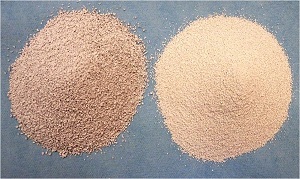
Military-grade versions of this media are currently under test in respirator filters by the Department of Defense. Non-military grade versions of this media have been independently tested and confirmed to out-perform carbon media for sulfur dioxide test gas, and is being considered for applications concerning human waste.

One significant advantage of this new filtration media is its performance for de-adsorption as compared to activated carbon. While activated carbon is known for its adsorption properties to filter unwanted odors, under common conditions such as higher humidity and temperature carbon can release those odors. By contrast, this new filtration material tightly contains these odors through a stronger molecular interaction. The result is a filter material that does not release its entrapped odors. Another significant advantage is its color, a pleasant off-white shade, as compared to dark black for activated carbon, which can enable the material to be applicable to a wide range of consumer goods.
Guild Associates' scientists are recognized experts in the field of molecular filtration, and have authored numerous papers and made presentations at industry trade shows. Listed below is a sampling of the peer-reviewed papers, presentations, and patents that exist for Guild Associates in this field. Whatever your application, Guild Associates is interested in talking to you about how this filtration media can result in a competitive edge in your industry. Contact us for a discussion on your application.
| 2012 | Peterson, G.W. and Rossin, J.A.; “Removal of Chlorine Gases from Streams of Air Using Reactive Zirconium Hydroxide-based Filtration Media.” Ind. Eng. Chem. Res. 51 (2012) 2675. Click Here to View Abstract |
| 2011 | Peterson, G.W.; Rossin, J.A.; Karwacki, C.J. and Glover, T.G.; “Surface Chemistry and Morphology of Zirconia Ploymorphs and the Influence on Sulfur Dioxide Removal.” J. Phys. Chem. C. 115 (2011) 9644-9650. Click Here to View Abstract |
| 2011 | Levasseur, B.; Gonzalez-Lopez, E.; Rossin, J.A. and Bandosz, T.J.; “Effects of Reduction Treatment on Copper-Modified Activated Carbons on NOx Adsorption at Room Temperature.” Langmuir 27 (2011) 5354-5365. Click Here to View Abstract |
| 2010 | Mahle, J.J.; Peterson, G.W.; Schindler, B.J.; Smith, P.B.; Rossin, J.A. and Wagner, G.W.; “Role of TEDA as an Activated Carbon Impregnant for the Removal of Cyanogen Chloride from Air Streams: Synergistic Effect with Cu(II).” J. Phys. Chem. C 114 (2010) 20083. Click Here to View Abstract |
| 2010 | Peterson, G.W.; Wagner, G.W.; Keller, J.H. and Rossin, J.A.; “Enhanced Cyanogen Chloride Removal by the Reactive Zirconium Hydroxide Substrate.” Ind. Eng. Chem. Res. 49 (2010) 11182. Click Here to View Abstract |
| 2010 | Peterson, G.W.; Karwacki, C.K.; Rossin, J.A. and Feaver, W.B.; Process for Removing Epoxides. U.S. Patent 7,713,334 (2010). |
| 2010 | Feaver, W.B. and Rossin, J.A.; Material and Process for the Removal of Nitric Acid and NO2 from Streams of Air. U.S. Patent #7,678,182 (2010). |
| 2010 | Maxwell, A.H. and Rossin, J.A.; “Effects of Airborne Contaminant Exposure on the Physical Properties and Filtration Performance of Activated, Impregnated Carbon.” Carbon 48 (2010) 2634. Click Here to View Abstract |
| 2010 | Peterson, G.W.; Rossin, J.A.; Smith, P.B. and Wagner, G.W.; “Effects of Water on the Removal of Methyl Bromide using Triethylene Diamime Impregnated Carbon.” Carbon 48 (2010) 81. Click Here to View Abstract |
| 2009 | Peterson, G.W.; Karwacki, C.J; Rossin, J.A. and Feaver, W.B.; “Catalytic Removal of Ethylene Oxide from Contaminated Airstreams by Alkali-Treated H-ZSM-5.” In Nanoscience and Nanotechnology for Chemical and Biological Defense, Chapter 18, 2009, pp 235-248 (ACS Symposium Series, Volume 1016). Click Here to View Abstract |
